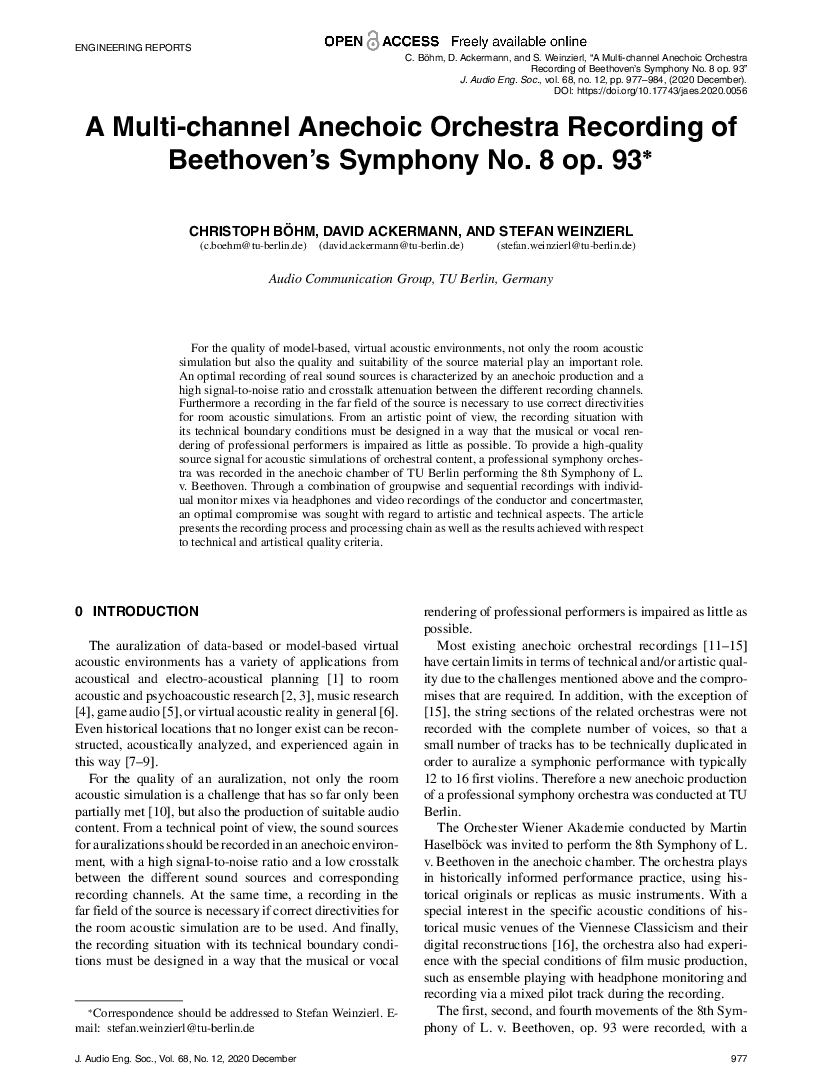Home / Publications / E-library page
You are currently logged in as an
Institutional Subscriber.
If you would like to logout,
please click on the button below.
Home / Publications / E-library page
Only AES members and Institutional Journal Subscribers can download
For the quality of model-based, virtual acoustic environments, not only the room acoustic simulation but also the quality and suitability of the source material play an important role. An optimal recording of real sound sources is characterized by an anechoic production and a high signal-to-noise ratio and crosstalk attenuation between the different recording channels. Furthermore a recording in the far field of the source is necessary to use correct directivities for room acoustic simulations. From an artistic point of view, the recording situation with its technical boundary conditions must be designed in a way that the musical or vocal rendering of professional performers is impaired as little as possible. To provide a high-quality source signal for acoustic simulations of orchestral content, a professional symphony orchestra was recorded in the anechoic chamber of TU Berlin performing the 8th Symphony of L. v. Beethoven. Through a combination of groupwise and sequential recordings with individual monitor mixes via headphones and video recordings of the conductor and concertmaster, an optimal compromise was sought with regard to artistic and technical aspects. The article presents the recording process and processing chain as well as the results achieved with respect to technical and artistical quality criteria.
Author (s): Böhm, Christoph; Ackermann, David; Weinzierl, Stefan
Affiliation:
Audio Communication Group, TU Berlin, Germany
(See document for exact affiliation information.)
Publication Date:
2020-12-06
Import into BibTeX
Permalink: https://aes2.org/publications/elibrary-page/?id=21011
(572KB)
Click to purchase paper as a non-member or login as an AES member. If your company or school subscribes to the E-Library then switch to the institutional version. If you are not an AES member Join the AES. If you need to check your member status, login to the Member Portal.

Böhm, Christoph; Ackermann, David; Weinzierl, Stefan; 2020; A Multi-channel Anechoic Orchestra Recording of Beethoven’s Symphony No. 8 op. 93 [PDF]; Audio Communication Group, TU Berlin, Germany; Paper ; Available from: https://aes2.org/publications/elibrary-page/?id=21011
Böhm, Christoph; Ackermann, David; Weinzierl, Stefan; A Multi-channel Anechoic Orchestra Recording of Beethoven’s Symphony No. 8 op. 93 [PDF]; Audio Communication Group, TU Berlin, Germany; Paper ; 2020 Available: https://aes2.org/publications/elibrary-page/?id=21011
@article{böhm2020a,
author={böhm christoph and ackermann david and weinzierl stefan},
journal={journal of the audio engineering society},
title={a multi-channel anechoic orchestra recording of beethoven’s symphony no. 8 op. 93},
year={2020},
volume={68},
issue={12},
pages={977-984},
month={december},}